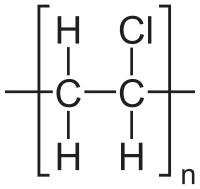The following are the synthetic petrochemical resins that are typical found in consumer products including food packaging. The first two are widely collected in recycling programs. All plastics present varying degrees of toxicity from production through end use and disposal. The table below summarizes some of these concerns.
| Name (Abbreviation) | Resin Code | Chemical formula | Toxicity |
|---|---|---|---|
| Polyethylene terephthalate (PETE) |
1 |
|
High risk: based on benzene and other problematic chemicals. Additional risks include additives. |
| High-Density Polyethylene (HDPE) | 2 |
|
Risks from additives, which are never revealed, but include categories such as UV inhibitors, colorants. |
| Polyvinyl Chloride (PVC) |
3 |  |
High-risk: chlorine-based. The vinyl chloride monomer is a known human carcinogen. Additional risks include additives such as plasticizers (e.g., phthalates). Additives are not listed. |
| Low-Density Polyethylene (LDPE) |
4 |  |
Risks from additives, which are never revealed, but include categories such as UV inhibitors, colorants. |
| Polypropylene (PP) |
5 |  |
Risks from additives, which are never revealed, but include categories such as UV inhibitors, colorants. |
| Polystyrene (PS) |
6 |  |
High-risk: based on benzene and other problematic chemicals. The styrene monomer is a probable carcinogen and is found as a trace element in polystyrene. Additional risks include additives. |
| Polycarbonate (PC) |
7 (see note) |  |
High-risk: based on benzene and other problematic chemicals. Additional risks include additives (such as bisphenols). |
Note: In the U.S., the 7 code is officially OTHER and can apply to any other plastic or a combination of resins (such as multi-layered). But 7 can optionally be annotated to identify a specific plastic such as polycarbonate or polylactic acid (PLA).
Sources and further reading:
Chelsea M. Rochman, Mark Anthony Browne, et al., "Classify Plastics as Hazardous Waste", Nature, 14 Feb. 2013, no. 494, p. 169–171. This article suggests PVC, polystyrene, polycarbonate and polyurethane are the most problematic plastics and should be classified as hazardous.
Blastic Project, "Toxicity of plastics".
Department of the Environment, Order Adding a Toxic Substance to Schedule 1 to the Canadian Environmental Protection Act, May 12, 2021. This adds all "Plastic manufactured items" to the list.
